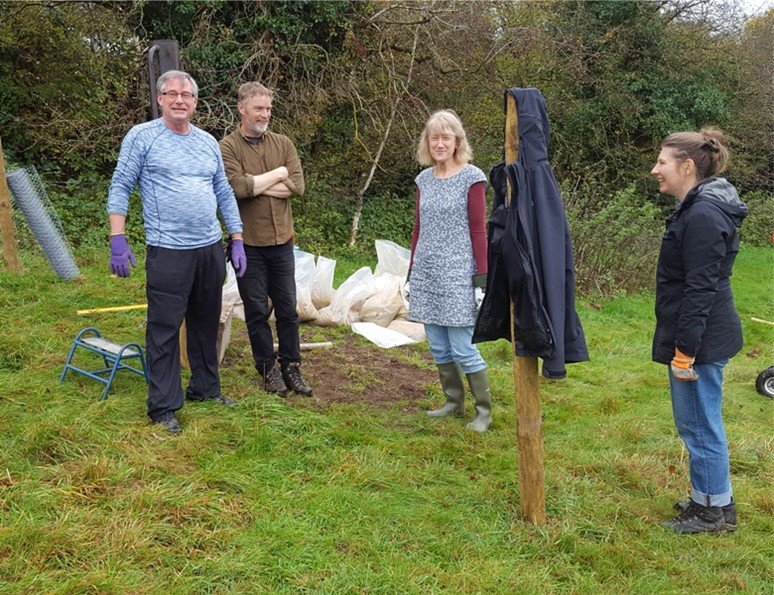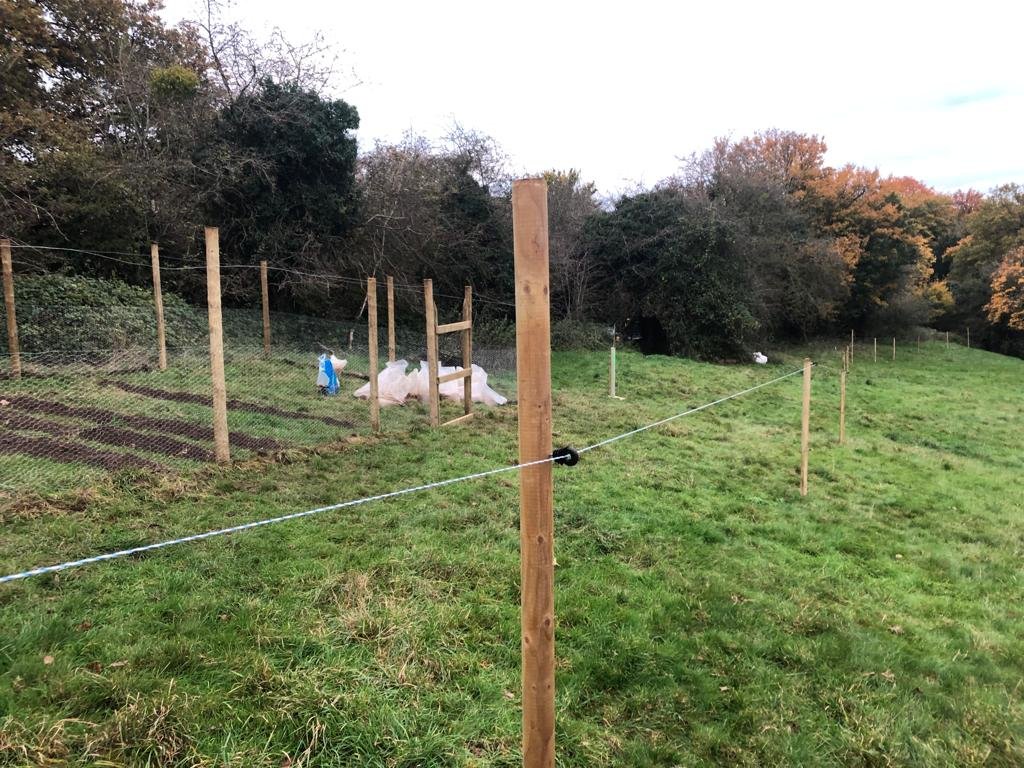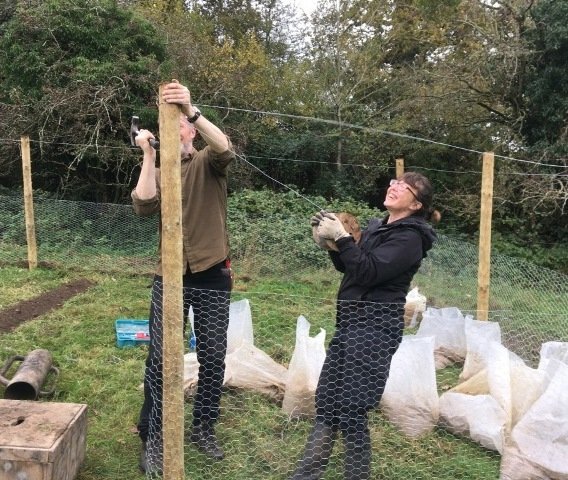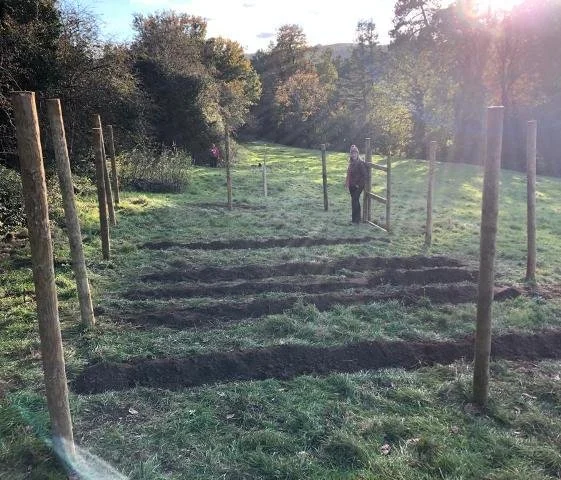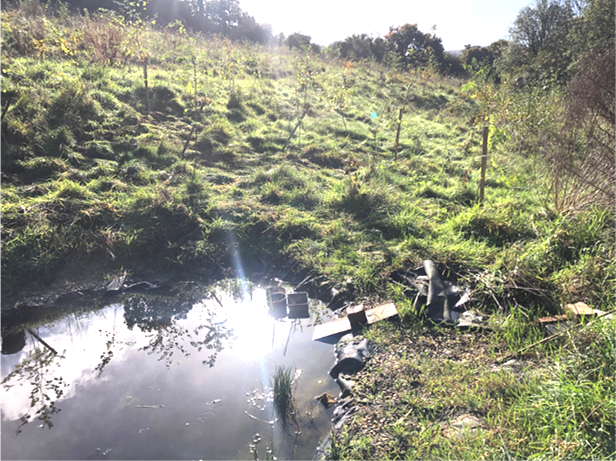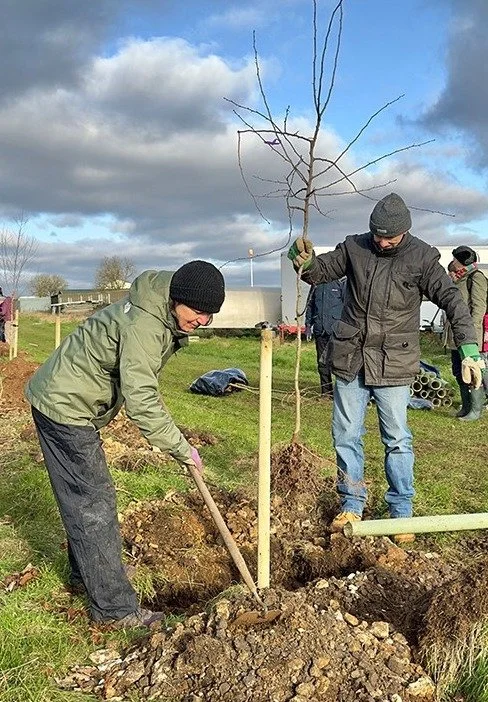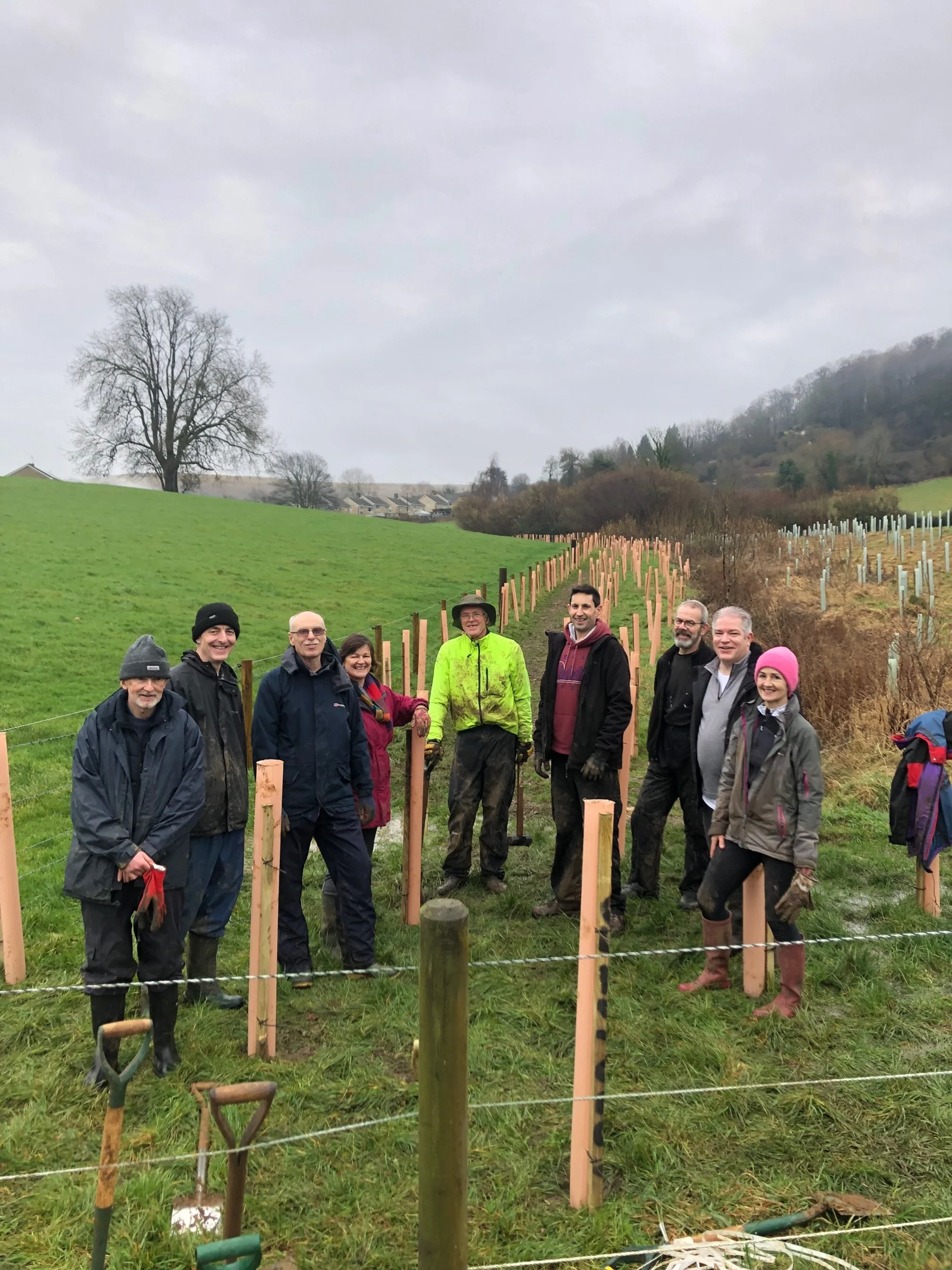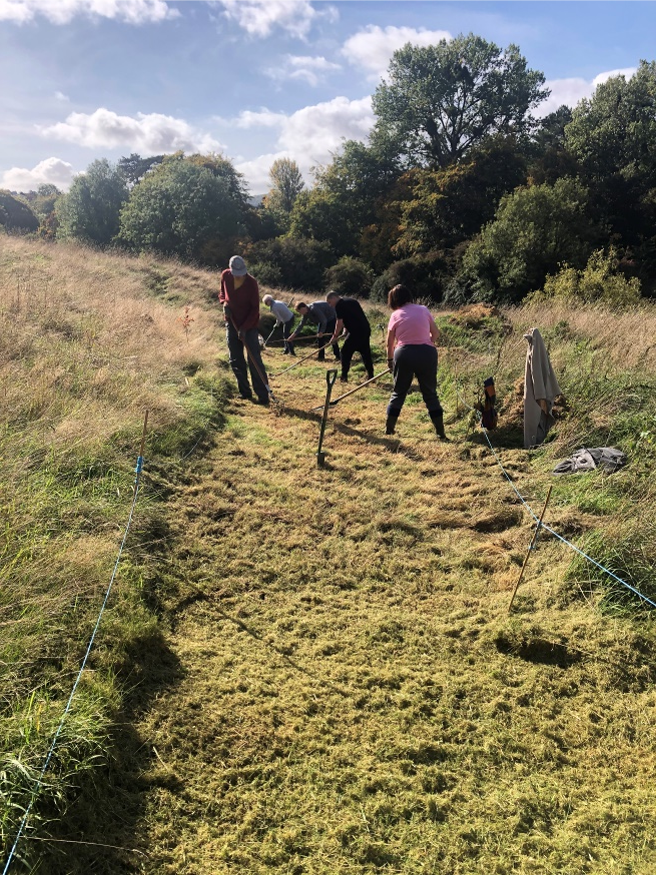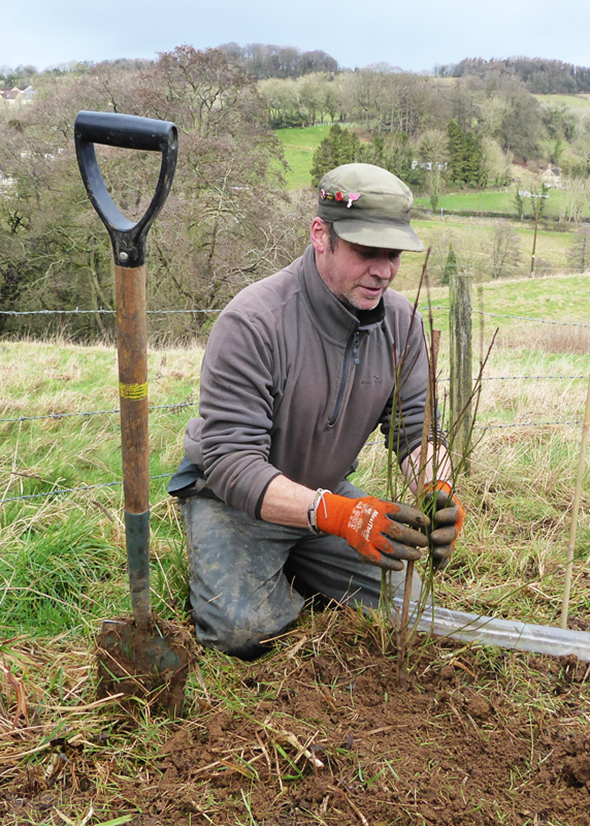Tree Planting
Stroud District Council and Stroud Valleys Project’s new woodland is on its way, with thousands of trees having been planted this winter, thanks to project officer Stuart Roweth and his band of volunteers. This initiative is supported by Gloucestershire County Council’s tree fund which has been granted funds by the Forestry Commission.
Woodlands are normally planted for timber production or recreation. At Salmon Springs, the planting is designed to absorb carbon dioxide and create habitats for wildlife.
Autumn 2024 update:
Tree group aspirations for winter 2024 by Stuart Roweth
We will have a busy schedule this season, with around 12,000 trees to plant in the Stroud area. Locations include Victory Park, Hammond's Farm, Sapperton Wilder, Bad Brook, Uplands Allotments, Bristol and Glos. Gliding Club, Calcot Manor, Charlea Community Gardens (Brimscombe), Oakbrook Farm and Ruscombe.
The work will be creating hedges, planting fruit trees, gapping up hedges, planting a few larger specimen trees (hopefully not in the snow this time), and planting riverside willows, agro-forestry trees, and so on.
Heaps of hedges Hedging has become one of the main activities of the tree group. Long interconnected hedgerows are perfect for creating habitats for mammals, insects and birds. We are using up to 15 varieties of native trees in some of our projects. Management of local hedges could be improved if they were left to grow taller and fatter, with a cutting regime that allows them to flower and bear fruit. Hopefully we can persuade landowners to let our hedges thrive, as they help create a strong dense foundation. Older hedges that are cut less frequently are also far better at providing for our vital insect populations.
Growth Rate study at Salmon Springs The tree planting group met once a month over the summer at Salmon Springs, doing maintenance work and gathering data on the growth rates of the different tree species. This work continues the measuring we began in the first summer after the 5 acres were planted. This trial is being conducted by Aleks Maljkovic.
Pond life We have put quite a lot of work into managing our two ponds at Salmon Springs. Both are doing well, but the lower pond is still keeping us busy. We have added some birch trees to give a little shade; this will hopefully help reduce the amount of blanket weed that’s been threatening to smother our pond plants.
Spring 2024: Tree planters branch out! by Stuart Roweth
The tree planting group have been learning new skills over the winter.
We braved the cold and wet, back in November, collecting hundreds of soil samples in the stony fields near Sapperton. These samples help Sapperton Wilder, a regenerative farming group, gather evidence about improving soil quality.
After planting trees on several sites, encountering frosty and frozen ground, but also muddy saturated ground, we embarked on another unusual activity for us: wildflower seed sowing.
The land we were working on is next to the runway at the Cotswold Gliding Club. Once the grass had been cut short and harrowed, we spread out in a long line and carefully shook our precious wildflower seed across the 7.5 acre field. It’s going to be fascinating to see how the flower seeds will develop and what density of wildflowers will be achieved. The glider club have invited us back to take a look in May or June; this will be a good excuse for a tree group get-together.
We are also lucky to have been involved with seven different tree planting projects this season, which will also be fascinating to catch up with, once the trees are in leaf and growing up and away.
Hopefully there will be some rain in the warmer months, otherwise we’ll be visiting again but with watering cans!
Spring 2023: Hedging our best by Stuart Roweth
We’ve now finished the 2022/23 planting season and looking back, it’s been very productive. Our tree group normally had around nine members planting native trees and native mixed hedgerows. At full speed we were planting up to 500 trees a day!
One of our most pleasant tree planting jobs was when we were asked to plant a mixed species wildlife hedge at the Wild Acres site in Breadstone near to Cam. Wild Acres has a relaxed, welcoming atmosphere where local people come to enjoy the two-acre forest garden. There’s a studio where craft workshops take place, a field kitchen and an orchard.
Our group was boosted up to 12 by some Wild Acres helpers and we managed to plant 900 trees over two days. This was quite an achievement as we also spent an hour each day enjoying a delicious lunch consisting largely of home-grown produce made in their outdoor kitchen.
The mixed hedgerow includes eight species of native trees planted densely in three rows, to form a wide swath of trees linking two areas of woodland. Dense wide hedges soon become valuable refuges for birds and mammals.
The hedge has had a great start. The ground was boggy when we planted in January, February was one of the driest on record, and March one of the wettest. This all adds up to pretty good growing conditions for young trees.
I look forward to checking progress at Wild Acres; I suspect these trees will thrive because they have people who have an interest in making a beautiful hedge and are able to care for them.
Volunteers are at the heart of making this project a success, as with all of SVP’s endeavours.
Update Winter 2022
We have kept an eye on things since March; there was just enough water in spring, so the trees had a fairly good start. Other hazards include rabbits, deer and badgers, who are digging up the trees if they get in their way.
By late June we were running out of moisture; by mid-July the situation was desperate. We had one hour of rain, which kept the trees alive for another week or so. In mid-August, we started watering. Luckily, a neighbour then kindly offered a large amount of grey water they had on site for our use. This watering made all the difference as the rains came in earnest during September. The trees have made it through their first season with around 15% lost, which is about what we would expect for the first year.
The site is mainly about woodland planting, but we have made space for two ponds which will be linked and accessed by a long strip of wildflowers.
Earlier work
Within the five acres of planting, several dense thickets were made, where the trees will grow more rapidly and provide cover for the insects, mammals and birds living there. Thickets occur in all mature forests; when a large tree falls, it creates a clearing and an opportunity for small trees to race for the light. We imagine they will be wild spaces for many years to come; our volunteers will be involved in maintaining these habitats for some months.
In all there are 34 species of native woodland plants and trees. We chose native trees because they offer more flowers, nectar, seeds and potential habitats to local wildlife. Many of these trees also have the potential to cope with what a changing climate might throw at them over the next 100 years. Some, like alder and willow, thrive in boggy ground; and others can cope better with droughts.
Stroud Valleys Project volunteers have achieved all this, putting in hundreds of hours of work. Beginning last November they planted through the winter, finishing at the end of March.
Instead of plastic tree guards, we are using an electric deer fence to protect the trees. The fence will be removed when the trees are older.
Later this year we are digging two ponds in the centre of the forest. Around these we’ve planted 400 hazel trees. The hazel can be managed to allow sunlight to reach the water; cutting hazel gives an opportunity for numerous forest plants and flowers to flourish.
We’ve been in a lovely article in the Financial Times about community tree planting.

